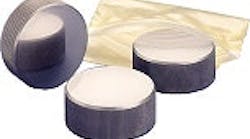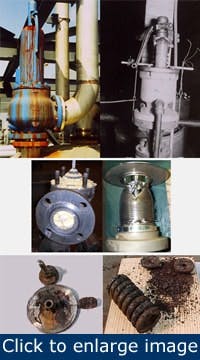The first law of physics, conservation of energy, has driven mankind’s pursuit of progress since the dawn of time. Efforts to harness the power of wind, water and fire brought about huge advances in technology. In time, fire and water were combined to bring on a steam-powered industrial revolution. Today, nuclear energy is converted to electricity to power our world.
The second law of physics, increasing disorder, is the reason that the equipment that harnesses, distributes and uses energy requires maintenance to continue operating properly. Machines deteriorate because of friction, vibration, corrosion, etc. Periodic maintenance must be performed to counteract the inevitable deterioration.
The energy required to operate and maintain manufacturing equipment typically is supplied by boilers or electric motors that power turbines, compressors, pumps and hydraulic systems. Pressurized fluids are capable of performing consistently over an extended period. However, fluids under pressure also pose a threat to property and personnel should an uncontrolled release occur. The catastrophic failure of a pressurized system can be fatal.
That’s why pressurized systems are protected from catastrophe by safety measures including preventive maintenance. The most important piece of equipment in a pressurized system, the pressure relief valve (PRV), is the one piece of hardware that must always be ready to operate properly when needed. However, the PRV also is the one piece of equipment we hope never needs to operate. Because the PRV is the last line of defense against a catastrophic failure of a pressurized system, it must be maintained in “like new” condition if it is to provide the confidence necessary to operate a pressurized system.
Run-to-failure is not an option
The run-to-failure philosophy isn’t an option with a PRV because failure might result in property damage or even loss of life. The minimum acceptable level of PRV maintenance is periodic testing, with internal inspection and repair as dictated by the results of testing.
Troubleshooting PRV problems is the first step in a proper repair. Unless you determine and correct the failure’s root cause, the problem will recur. Repair shops across the country are qualified to perform PRV repair and testing. Working to a nationally recognized standard, PRV service facilities disassemble, clean, inspect, machine or replace parts (as necessary), reassemble, test, seal and apply a repair nameplate for traceability.
Troubleshooting starts with the installation and application
Figure 1. Various failure modes. Clockwise from top left: plugged drain, run beyond failure, ruptured bellows, corroded springs and washers, component corrosion, clogged with product.
Troubleshooting begins with the piping configuration, physical orientation and application data such as system pressure, temperature and physical properties of the contained fluid. You’ll need to address installation issues such as stress from vessel and piping expansion and unsupported discharge lines. In addition, improper valve application can result in mechanical damage from elevated temperature, backpressure, material incompatibility or incorrect pressure setting (Figure 1).
Installation problems often result in PRV operational malfunction. Trained and qualified maintenance personnel might recognize and correct such issues. Proper PRV installation is the first step in preventive maintenance. However, an improper installation that causes a PRV failure to shut down the system also causes an unscheduled emergency repair. While installation problems are outside the scope of the typical PRV repair, conscientious PRV repair shops will keep the user informed. Failure to correct installation problems will result in repeated PRV malfunctions, thereby shortening the PRV’s life expectancy and raising the cost of unscheduled downtime, additional repairs, spare parts and possibly fines for fugitive emissions.
Inspect, replace, recondition
After disassembly and cleaning, a trained and qualified PRV technician examines the PRV parts. Such critical inspection is the key to the repair process because the results affect quality as well as economic issues. The inspection includes a comparison of component dimensions to the OEM’s acceptance criteria to determine the disposition of the part — use as-is, remachine in accordance with OEM criteria or replace with OEM parts.
Figure 2. Cast iron lapping blocks.
Spring range is compared to OEM charts. Inspection points include the clearance between the adjacent sliding surfaces in the guide area. Valve spindles are checked for concentricity and runout - a bent spindle adversely affects alignment. In some instances, the scope of work the critical inspection suggests makes it uneconomical to repair the valve.
Following the inspection, disc and nozzle seats are reconditioned by machining and lapping (Figure 2) to the proper finish to ensure the seat tightness that reduces fugitive emissions.
{pb}
Reassemble and test
Once the seats are lapped, PRVs are reassembled and made ready for testing. Any unacceptable parts are replaced. Only OEM parts may be used for these repairs to maintain the traceability back to the nationally-recognized standard in force during the repairs. Adjustments are returned to the OEM recommended settings.
Figure 3. Pressure relief valve test bench, for verifying set pressure and seat tightness on air or water up to 3000 psi.
Following reassembly, each valve is tested (Figure 3 and Figure 4) to demonstrate set pressure and seat tightness in accordance with the nationally-recognized standards. Trained and qualified technicians test using fluids similar to the intended service. Steam PRVs are tested on steam. Valves for other compressible fluids may be tested on air or gas. PRVs in liquid service are tested on water or other suitable liquid.
Repair nameplates
Upon successful test completion, the repaired PRV is sealed to identify the responsible repair organization and prevent unauthorized tampering. Finally, a metal repair nameplate is affixed that displays the set pressure, date of repair, and a unique identifier that links the PRV to a document or traveler containing a record of the scope and extent of repairs performed. Every nationally-recognized PRV repair shop is required to document repairs and maintain the records for at least five years. This repair history is helpful for subsequent troubleshooting.
Figure 4. Water service pressure relief valve mounted on test bench.
Primary concerns for manufacturing plants include maintaining safe operation, minimizing unscheduled downtime and preventing environmental degradation. Improperly maintained PRVs pose a danger to equipment and personnel and contribute to unscheduled outages because they don’t operate consistently.
Such inconsistent operation might cause a PRV to fail meeting no less than three nationally-recognized requirements, set pressure tolerance, seat tightness criteria and flow rated capacity. In addition, inconsistent operation often results in leakage across the valve seats. Although a seat tightness test is performed following repair, misalignment caused by in-service piping stress might cause lateral binding, the leading cause of inconsistent PRV operation.
Repair by a nationally-recognized PRV repair organization includes troubleshooting, disassembly, inspection, machining, lapping, part replacement, reassembly, testing, sealing and application of a repair nameplate.
Properly repaired PRVs protect manufacturing facilities from catastrophic failure, reduce unscheduled downtime and prevent pollution. To have the highest possible level of confidence in plant safety, it’s imperative that you contract only with a nationally-recognized repair facility when PRV maintenance is needed.
Alton Cox is trainer and consultant at Deluca Test Equipment, Inc. in Charlotte, N.C. Contact him at [email protected] and (704) 392-9432.






